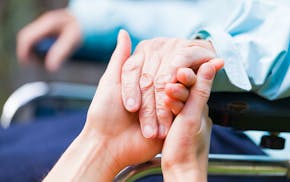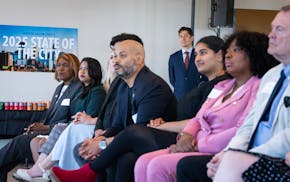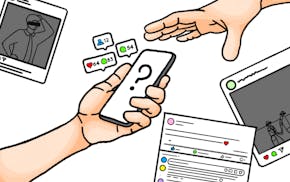"It's not the same place," my friend Quincy warned me before I rolled into Kirkwood, an eastern neighborhood of Atlanta. "It's changed altogether.
"Back when I was growing up, it was mostly people of my complexion (he's Black). Now it's mostly people of your complexion (I'm white)."
I saw what he meant as soon as I got there.
The stories Quincy had told me — of an upbringing scarred by lack of resources and more than occasional violence, but buoyed by a tightly knit community of color — faded into a palette of pastels; white people pushing strollers and storefronts boasting eco baby goods and cold-press juices.
As late as 1990, this arboreous district on the city's fringe was only 1% white. But around that time, thanks to Kirkwood's affordable housing and convenient location, a turning point was reached amid the sprawl of Atlanta, one of the country's fastest gentrifying cities. By the early 2000s, property taxes had doubled or even tripled, forcing many Black residents to leave longtime homes.
As of the last census, Kirkwood's white population had become the majority.
The rapid change showed on the pristinely manicured streets, with old-school barbecue restaurants abutting coffee and craft beer hybrids; having glimpsed the old Kirkwood through the tales of Quincy — who currently lives in Los Angeles — the difference was jarring.
I was at the culmination of a spontaneous, 10-day, 640-mile road trip from Memphis to Atlanta, following the alternately heavy and hopeful arc of the 1960s civil rights movement, tracing the Rev. Martin Luther King Jr.'s legacy from the hotel where he was shot, to the bed where he was born — and lingering at many less-famous places in between.
On the heels of nationwide protests supporting the Black Lives Matter movement, signs of the continuation of the work of King and so many others were inspiringly present — BLM T-shirts sold on street corners; impassioned street tags preserved on unwashed public buildings.
But a jaunt through the former Jim Crow south also acted as a gauge of just how far we have to go — from the homeless camps in walking distance from MLK's home, to the abject poverty evident in a hitchhiker's neighborhood, to the thinly veiled racism I experienced on the streets of Memphis. Transpiring simultaneously with the demonstrations fighting police brutality that have seized widespread attention, these quiet injustices — the faces of which are still overwhelmingly Black — manage to persist, I found, in relative anonymity.
• • •
The highways that cut through the Gulf coastal plain are mostly flat, lined by turns with cornfields, logging trucks and catfish feed mills marking the space between one-road towns boasting track clubs and barbecue joints — a fat-laden passage from the mustard bases of Tennessee, to the thick, sweet red glazes of Mississippi, to Alabama's signature white sauce.
Here, vegetables are fried. Tea is sweet. Patrons are called "Sugar." And the populations, by and large, are white and conservative.
That is, except in a handful of cities and towns where the Black/white percentages reverse — progressive islands surrounded by a high tide of red.
In Memphis, the National Civil Rights Museum — where Black history is presented, powerfully, through modern Black perspectives — emotionally guides visitors through an interactive experience from the start of slavery to the Lorraine Motel where King died. Down the block, on Beale Street, diverse Black culture and the buoyant music scene that vibrates the corridor in non-COVID times is celebrated and mainstreamed.
In other parts of the city, though, deep evidence of institutional repression remains. With a population that is 63% Black, Memphis ranks as the third most distressed city in the U.S., with much of that deterioration flowing from the 2007 financial crisis.
"Before 2007, three quarters of the population owned, a quarter rented," a server at the BBQ joint Rendezvous told me. "After the housing market collapsed, it flipped. People say 'Oh, that's a coincidence.' It wasn't."
On the western edge of downtown, Tom Lee Park abuts the seductive curve of the Mississippi River dividing Arkansas and Tennessee. In the evenings, Memphians flock to its shores to revel in the pink-gold sunsets. As I walked back into the city core one evening, a man whipped his car over to the sidewalk.
"You picked the wrong place to be walking around alone," he told me, adding, for emphasis, "it's really bad here."
"Really?" I asked, looking around. Beyond me were kids on scooters, laughing families, manicured sidewalks. The only distinction I could find was that most everyone was Black, and he and I were white.
Just over 200 miles away, Jackson, Miss., is home to the wonderful Mississippi Civil Rights center detailing the fight inherent in the freedom schools of the summer of '64, and to Mayor Chokwe Antar Lumumba, who ran on the slogan of making his city, at 79%, the third-greatest ratio of Black people in the country, "the most radical city on the planet."
But in a state that was once the nation's top producer of cotton, it's hard to ignore the pocked city streets, where one can't go too fast anywhere because entire wheels might be engulfed in child-sized potholes.
One day, while I was taking photos on the side of the road, a woman named KiKi asked me for a ride to her home. When we arrived at the residential triangle that sits between Medgar Evers Boulevard, Woodrow Wilson Avenue and Martin Luther King Drive, I stifled a reaction. Lot after lot, roofs collapsed atop their residents. The grass in public parks grew to knee level. A graveyard consisted of worn stones, seemingly tossed amid a field.
Speaking of the infrastructure neglect, a Jackson native and bartender later lamented, "We're caught between the right-wing state politics.
"We're the last ones, always the last."
• • •
Around Birmingham's Kelly Ingram Park, a downtown green space honoring civil rights moments and figures through moving monuments, one can witness evidence of our current political moment, too. "Black Lives Matter" was etched on the historic 16th Street Baptist Church marquee. Around town, dynamic street art pronounced we are "better together" and cheers "Nothing but Love." An hour through and around the park might also bring encounters with multiple Black people experiencing homelessness; a U.S. epidemic that remains largely disconnected from mainstream media focus and public agitation.
Such stirring art graces all corners of Atlanta, too, serving as the opening acts leading to Sweet Auburn, the neighborhood where Martin Luther King was born.
Outside his home, which was closed due to coronavirus, a Black man took selfies on the steps with his young daughter. Another man, traveling alone, wore his excitement on his face. "It's the first time I've visited this," he told me.
That area, called Sweet Auburn, is still primarily Black. The median income is $41,000 per year. Blocks away, the trendy Inman Park, where French cafes flourish alongside food halls, is 82% white. The median income is $94,000.
I had a burger and drove 10 minutes down Hwy. 23 to Kirkwood. Past the sign that pronounced the neighborhood's Civil War history — where the Battle of Atlanta began — past a perky commercial core touting yoga studios and vegan bakeries, are tree-lined residential avenues, where Quincy was raised.
Here was a white man, unloading lumber from his SUV; no doubt the start of a home improvement project. There was a white woman, ushering her kids in the front door. What struck me as much as anything were the signs, in nearly every yard. Pristinely printed on black poster board and driven into the soil with sturdy metal pins, they faced outward, proudly presenting their message to the world.
Black Lives Matter.
As for most of the Black lives themselves, they moved out a long time ago.
Amelia Rayno is a former Star Tribune journalist at work filming a docuseries project exploring food, culture and U.S. imperialism. Reach her at ameliarayno.com or on Instagram: @ameliarayno.

Rash: At home, Jake Sullivan reflects on events abroad

Opinion: Let's not lose sight of what's best for older adults

Readers Write: Minneapolis politics, Trump's budget, hot tub rentals

